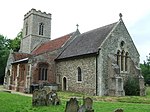Thredling Hundred
Hundreds of Suffolk
Thredling was a hundred of Suffolk, and at just under 10,000 acres (40 km2) the smallest of Suffolk's 21 hundreds.The five parishes of Thredling fall into the Deanery of Claydon, the Archdeaconry of Suffolk, and the Diocese of Norwich. The hundred was bounded by Loes, Carlford, Hoxne, Hartismere and Bosmere and Claydon. The River Deben has its source here. It was one of seven Saxon hundreds grouped together as the Wicklaw Hundreds.The origin of the hundred's name is not known, though one theory derives it from "Thrythhild", known to be a female first name of the Saxon era.
Excerpt from the Wikipedia article Thredling Hundred (License: CC BY-SA 3.0, Authors).Thredling Hundred
Low Road, Mid Suffolk
Geographical coordinates (GPS) Address Nearby Places Show on map
Geographical coordinates (GPS)
| Latitude | Longitude |
|---|---|
| N 52.22 ° | E 1.18 ° |
Address
Low Road
Low Road
IP14 6QU Mid Suffolk
England, United Kingdom
Open on Google Maps








